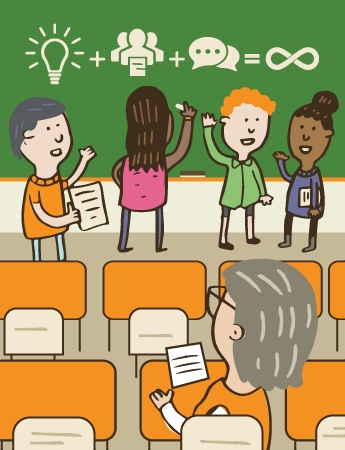You’ll recognize the adage: it’s a quote from George Bernard Shaw’s 1905 play, Man and Superman. Two characters are talking and Bob says, “I’m so discouraged. My writing teacher told me my novel is hopeless.” Jane replies, “Don’t listen to her, Bob. Remember: those who can, do; those who can’t, teach.”

‘The flow of ideas and creative energy was like a boomerang…’ Illustration by Josh Quick.
It’s perhaps an interesting way to transfer blame, but nothing could be further from the truth. (Although, there are those who claim to be teachers and really can’t teach, as well as those who claim to be doers, but really don’t do anything.)
I am a writer and a teacher. I’m also an artist and musician. Why do I teach? It started as a means of securing a second, much-needed family income. I had studied piano most of my life so setting up a home studio sounded (no pun intended) like a great idea.
I could be home for my kids before and after school. There were no extra costs for childcare or transportation to and from work. I could set my own schedule. As my writing career developed, I added classes in creative writing for all ages, both in person and online. And another old adage took root: “Practice what you preach,” or, in this case, teach.
Most of my students preferred writing fiction. The younger ones, in particular, enjoyed the idea of writing fantasy and science fiction, probably in the hopes of becoming the next J.K. Rowling over the course of our 8-week class. After countless exercises in writing descriptive passages, we would launch into a story, constructing it from a well-planned plot map that would ideally evolve into detailed character development. My young students argued that plot maps were a waste of time and they just wanted to write. I argued that a detailed plan would help prevent unnecessary, unwanted tangents and keep the story’s development on track.
They grumbled. I insisted.
They outlined their stories. I went home and did the same.
I grumbled, too, but to myself. I knew that I should follow the procedure I was teaching and I discovered that it improved my writing, considerably.
Many of these students wanted their work to explore other dimensions. It didn’t matter which prompt we started with; the result was almost always some kind of fantasy or science fiction adventure. Although I had read some in these genres, I had never written anything of this kind until I started teaching. When I listened to my students read their finished stories, my mind would explode with ideas.
Two class exercises that really worked:
1. Write about an unplanned flight to Mars (based on the 2025 Mars One expedition). This exercise resulted in several fascinating plots, including the discovery of the true source of Mars Bars. Turns out, space travel, exploration, and possible settlements on another planet inspired me as well. I was moved to write about my own experiences as a young person, which included watching Neil Armstrong take that first step on the moon.
2. Write about a school trip to an art gallery, during which students are magically drawn inside a painting. The plot points must include the students adjusting to their life inside the artwork, saving the artist (and ensuring also that the painting is finished), and finding a way back to the art gallery.
These exercises led the young writers on a number of marvelously creative journeys. Motivated by some of these student’s ideas, I started work on two projects of my own: a young adult novel involving time travel, and a fantasy story for middle grades readers. The flow of ideas and creative energy was like a boomerang—what I shared with my students bounced back in exciting and diverse ways.
What did I learn? As I worked through the basics with students, I reinforced my own dedication to using these tenets in my writing. I learned from my students, and was inspired by them, and I like to assume it was mutual. Through brainstorming, group work, and conversation, I discovered that the sky was not the limit; neither was the universe which, in effect, is endless.
Note: The opinions expressed by guest bloggers at the Submittable blog are theirs alone and do not necessarily reflect the opinions of Submittable.
Emily-Jane Hills Orford is the author of many books, including the award-winning books, Gerlinda, To Be a Duke, F-Stop: A Life in Pictures, and The Whistling Bishop. She teaches music and creative writing to creative young minds of all ages. For more information on the author, check out her website at: https://emilyjanebooks.ca.